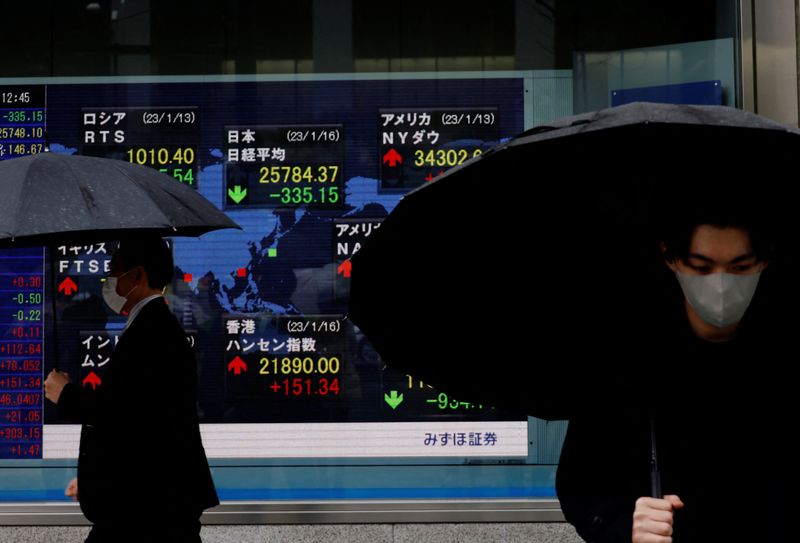By Caroline Valetkevitch
NEW YORK (Reuters) - The dollar weakened against the Japanese yen on Tuesday amid expectations of a possible policy shift at the Bank of Japan, while stocks on Wall Street mostly fell following disappointing quarterly results from Goldman Sachs (NYSE:GS).
Japan's decades of ultra-low interest rates may reach a turning point on Wednesday, when the BOJ decision is expected following a two-day meeting.
While other central banks have been raising interest rates to control inflation, the BOJ has kept long-term rates around zero.
A shift could possibly end its stimulatory policy called yield curve control (YCC).
The dollar extended recent weakness against the Japanese yen and was last down 0.3%, with investors braced for sharp moves when the BOJ concludes its meeting.
"If the BOJ decides to just tweak their operations, we could see a rebound in dollar/yen," said Joe Perry, senior market analyst at FOREX.com and City Index in New York.
In Treasuries, longer-dated U.S. yields rose as investors awaited the outcome of the BOJ meeting and prepared for the likelihood of an increase in corporate debt supply.
Japanese 10-year government bond yields topped the BOJ’s policy ceiling for a third straight session on Tuesday amid the speculation that policymakers could tweak stimulus settings.
If the Japanese central bank unwinds its yield curve control, it is likely that Japanese yields would increase further.
That could make the debt more attractive compared with U.S. Treasuries after accounting for foreign exchange hedges. Japanese investors may then sell U.S. government debt or be less likely to purchase it.
On Wall Street, investor focus was on quarterly earnings reports, with the Dow and the S&P 500 both ending the day lower, and shares of Goldman Sachs Group falling 6.4%. Shares of Travelers (NYSE:TRV) dropped 4.6% after the insurer announced preliminary fourth-quarter earnings.
Goldman reported a bigger-than-expected 69% drop in fourth-quarter profit. Results from JPMorgan (NYSE:JPM) & Chase and others on Friday kicked off the U.S. fourth-quarter reporting period.
The Dow Jones Industrial Average fell 391.76 points, or 1.14%, to 33,910.85, the S&P 500 lost 8.12 points, or 0.20%, to 3,990.97 and the Nasdaq Composite added 15.96 points, or 0.14%, to 11,095.11.
The pan-European STOXX 600 index rose 0.40% and MSCI's gauge of stocks across the globe shed 0.02%.
Chinese data showed that the world's second-biggest economy grew 2.9% in the fourth quarter of last year, beating expectations but underscoring the toll exacted by Beijing's stringent "zero-COVID" policy.
China's growth for 2022 of 3% was far below the official target of about 5.5%. Excluding a 2.2% expansion after COVID-19 first hit in 2020, it was the worst showing in nearly half a century.
Benchmark 10-year note yields rose 2 basis points to 3.53% while two-year Treasury yields dipped 5 basis points to 4.19%.
In the energy market, oil prices rose on hopes that a recent shift in China's COVID-19 policy could increase fuel demand.

Brent crude futures rose $1.46, or 1.7%, to settle at $85.92, while U.S. West Texas Intermediate (WTI) crude climbed 32 cents, or 0.4%, to $80.18.
Cryptocurrency bitcoin has clocked a gain of about a quarter in January, leaping over 20% in the past week alone, putting in on course for its best month since October 2021. It was last up 0.6%.